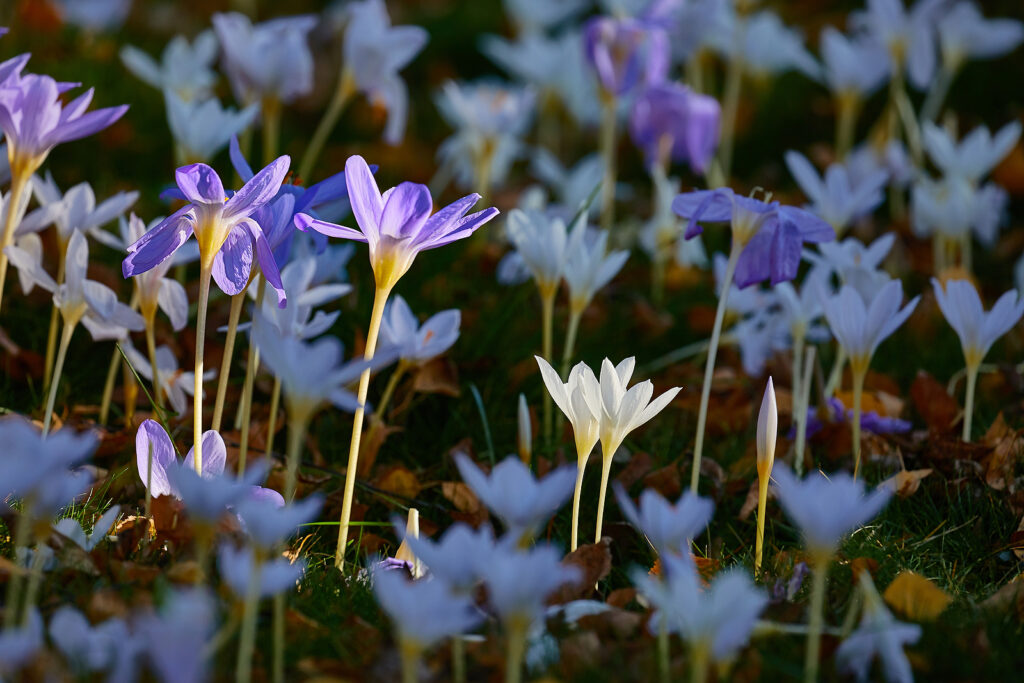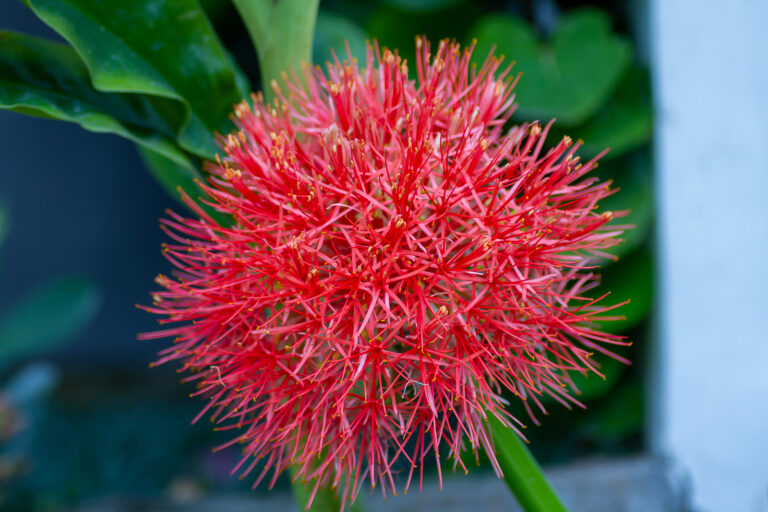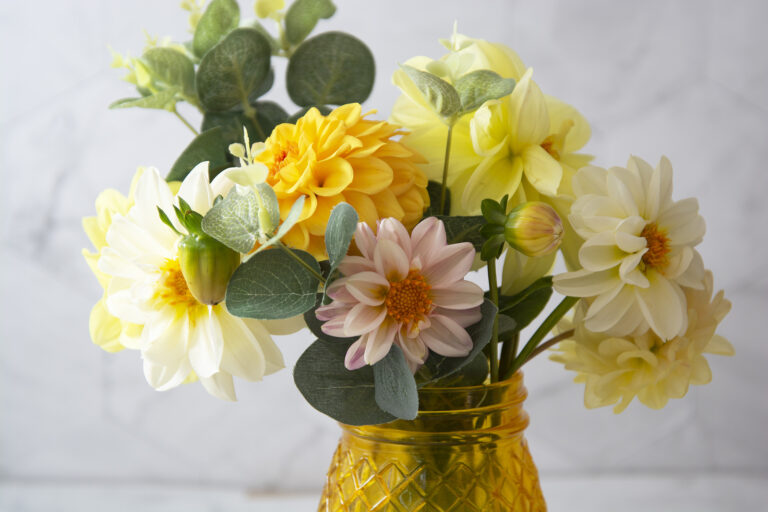How to Grow Crocus
Crocus produces small, goblet-shaped flowers that open in autumn, winter, or spring to reveal inner petals in contrasting colors. Crocus is a clump-forming perennial that grows from corms. Leaves are erect and lance-shaped. In autumn species, the flowers appear before the leaves.
Crocus is a genus of hardy cormous or bulbous plant members of the Iris family. Crocus comprises many species. Seasonally, crocuses are divided into two main groups–those that bloom in the fall and those that bloom in the spring.
This article is about spring-blooming crocuses; a separate article is about Autumn Crocus.
Because of their brilliant coloring in the very early spring before most other flowers appear, the spring crocuses are extremely popular. the best effects are obtained when they are massed but informally planting of individual colors may also be had in front of shrubs or evergreens, on the edge of perennial borders, or scatted through grass that can be left unmowed for several weeks.
If the foliage is left uncut to die down naturally, the corms will increase from year to year and continue to bloom profusely until they become crowded they can be dug up and replanted while dormant in midsummer.
Corms of spring-flowering crocuses should be planted by mid-autumn spaced about 3 inches apart and set about 3 inches deep.
Crocus flower colors range from pure yellow through the various lavender and blue shades to pure white.

Get to know Crocus
- Plant type: Hardy bulbs
- Growing Zones and range: Zones 5 to 9, farther north with shelter
- Hardiness: Most types will survive temperatures to -10°F; tolerant of heat; crocus need chilling in winter to provoke blossoming
- Height and width: 3 to 9 inches (7.6-22cm) tall and wide
- Flowers: Flowers are yellow, white, lavender, purple, violet-blue, or pink; some flowers are striped or have contrasting colors on each side of the petals
- Bloom time: Bloom autumn, late winter, or early spring-blooming (before narcissus) depending on the variety
- Uses: Plant in drifts in mixed borders, rock gardens, or naturalized in short grass
- Common name: Crocus
- Botanical name: Crocus spp.
- Family: Iridaceae
- Origin: Coastal and subalpine areas of Central and South Europe, North Africa, Central Asia, Western China

Where to plant Crocus
- Plant crocus in full sun or light shade.
- Grow crocus in humus-rich, well-drained soil.
- Crocus prefers a soil pH of 6.5 to 7.5

When to plant Crocus
- Plant crocus in mid-fall in Zones 3-6; plant in late fall in Zones 7-8.
- Plant seeds indoors in spring.
- Plant seed outdoors in late spring.
- Plant corms of spring-blooming crocus outdoors in fall; plant fall-blooming species in summer.
- Spring bloomers may be forced in pots set in cold frames in autumn and then brought indoors in winter.

Planting and spacing Crocus
- Sow seed indoors 1/8 inch deep in small pots or flats. Grow in temperatures from 55° to 75°F (12.8°-24°C); crocus germinates in about a month but takes two or three years to bloom when grown from seed.
- Sow seed outdoors in finely tilled soil.
- Plant corms 3 inches (7.5cm) deep.
- Space crocus 3 to 6 inches (7.5-15cm) or more apart depending on the variety.

How to water and feed Crocus
- Crocus needs moderate water; keep the soil evenly moist.
- Water during active growth in spring and after planting in summer or fall.
- Fertilize crocus at planting time with a bulb food; fertilizer after blooms fade to nourish next year’s growth and blooms–use a bulb food high in phosphorus.

Crocus care
- Place an inch or two of mulch over corms for winter protection in Zones 3-6.
- Remove winter mulch in stages in late when and spring when sprouts appear.
- Remove flower heads and stems after flowers fade unless you want to collect seeds.
- Let leaves die back naturally; remove them when they are yellow or brown. Mark the spot on a garden map so you know where plants will reappear next year.

Growing Crocus as a houseplant
- Crocus requires a cold treatment before it will flower; purchase prechilled flowers or refrigerate them for a month before planting
- Grow Crocus in an all-purpose =, well-drained growing medium; do not fertilize.
- After chilling, potted plants should be placed in bright light in a cool room with average humidity.
- Keep the plant evenly moist.
- Crocus will bloom in about two weeks.
- After flowers have faded, the bulbs can be discarded; they will not rebloom indoors.
Crocus common problems
- Mice, voles, and squirrels may feed on crocus corms.
- Deer may eat crocus blossoms; interplant crocus with narcissus which is toxic and repels deer.
- Birds sometimes pick off flowers.
- Corms in storage are susceptible to rot.
Crocus propagation
- Divide crocus every two years or when clumps become crowded; divide clumps when foliage begins to yellow following bloom time.
- Tease tangled roots and corms apart; do not cut through corns with a knife or spade.
- Replant corms and cormels after division.
- To propagate crocus from seed see above.

Crocus varieties to grow
- Crocus ancyrensis, golden bunch crocus. Blooms late winter to early spring; bright yellow to orange-yellow flowers marked with maroon-brown on the outside.
- C. angustifolius, cloth-of-gold crocus. Blooms mid-winter to mid-spring; orange-gold, star-like flowers with dark brown center stripe.
- C. biflorus, Scotch crocus. Blooms early spring; white or lilac=blue flowers with yellow throats; several cultivars in other colors.
- C. cartwrightianus, fall crocus. Blooms fall- to early winter; fragrant lilac to white flowers with brilliant orange styles.
- C. chryanthus, snow crocus. Blooms in spring; orange-yellow, sweet-scented blooms; a range of hybrids in many colors.
- C. etruscus. Blooms late winter to early spring; lilac flowers with yellow throats.
- C. flavus. Blooms in spring; orange-yellow flowers.
- C. goulimyi, fall crocus. Blooms fall; rosy lilac flowers.
- C. imperati, Italian crocus. Blooms early spring; bright lilac inside, buff veined purple outside.
- C. korolkowii, Celandine crocus. Blooms late winter to early spring; golden yellow flowers feathered with brown on the outside.
- C. kotschyanus. Blooms early fall; pinkish lavender or lilac flowers.
- C. laevigatus. Blooms fall- to early winter; white or lilac flowers are yellow-tan on the outside and streaked with violet-purple.
- C. longiflourus. Blooms fall; fragrant pale to dark lilac flowers.
- C. medius. Blooms fall; pale to dark purple flowers with brilliant orange styles.
- C. minimus. Blooms late spring; lilac-purple flowers and yellow-buff outer petals marked in dark purple.
- C. niveus. Blooms in fall; white or pale lilac flowers with orange styles.
- C. ochroleucus. Blooms fall; creamy white flowers with yellow throats.
- C. pulchellus. Blooms fall to early winter; pale lilac-blue flowers with yellow throats.
- C. sativus, saffron crocus. Autumn bloom; orange-red stigma is true saffron; to harvest saffron, pluck the stigmas as soon as the flower opens, dry them, and store them in a glass jar.
- C. sieberi. Early spring bloom; delicate lavender-blue flower with golden throat.
- C. speciosus, fall crocus. Blooms early fall; showy blue-violet flowers; showiest autumn-flowering crocus.
- C. tommasinianus. Blooms mid- to late winter; star-shaped, silvery lavender-blue flowers, sometimes with dark blotch tips.
- C. vernus, Dutch crocus. Blooms late winter to mid-spring; most vigorous and most widely sold; shades of white, yellow, lavender, and purple.
- C. versicolor.
Crocus chrysanthus — Snow Crocus
Snow crocuses are smaller and bloom earlier than Dutch hybrid crocuses. Snow crocuses produce more flowers per corm than Dutch crocuses. The species has bright orange flowers and bronze markings on the petal exteriors; hybrids may be white, cream, yellow, blue, and purple, and are often bicolored. Flowers are fragrant and long-lasting. They appear in late winter, at the same time as the narrow, upright, spiky leaves, which elongate after blooming and then die down. Corms increase rapidly.
- Size: Flowers 3 to 4 inches tall; leaves to 10 inches high.
- Light: Full sun to light shade from deciduous trees.
- Soil and moisture: Sandy to average, well-drained, acid to neutral soil. Requires moisture during growth; tolerates it when dormant but best in a summer-dry site.
- Planting and propagation: Plant corms in fall, 2 to 5 inches deep and 2 to 3 inches apart. Divide only when crowded and during dormancy.
- Special care: For the earliest bloom, plant where the sun warms the soil in late winter. Where naturalized in the lawn, do not mow leaves until at least six weeks after blooming.
- Pests and diseases: Rodents may eat corms.
- Climate: Hardy in Zones 3-11; best performance in Zone 7 or colder.
- Cultivar and similar species: ‘Prinz Claus,’ white inside, purple blotched outside; ‘Lady Killer,’ white inside, deep purple-edged white outside; ‘Blue Ribbon,’ light blue, ‘Purity,’ white; ‘Advance,’ yellow inside, lavender outside; ‘E. A. Bowles,’ lemon yellow with bronze veins; ‘Princess Beatrix,’ pale blue with yellow bases. C. tomasinianus; lilac-mauve; ‘Barr’s Purple,’ large lavender-blue.
- Garden use: Plant in groups of 50 or more for best effect in fronts of borders and rock gardens; naturalize in lawn or meadow.
Crocus sativus — Saffron Crocus
The large forked scarlet stigmas of Crocus sativus are the source of saffron, an expensive spice. The 4-inch-long, fragrant, lilac-purple blossoms appear in autumn, along with short, spiky leaves, which elongate after blooming and last through winter.
- Light: Full sun to light shade.
- Soil and moisture: Fertile, well-drained soil; moderate moisture when growing.
- Planting and propagation: Plant corms in summer, 4 to 6 inches deep and 4 to 6 inches apart. Divide every one to three years when leaves die in spring, and replant in improved soil.
- Special care: To harvest saffron, pick stigmas, which protrude from the top of the flower, when flowers open; let dry, and store in a plastic or glass vial.
- Pests and diseases: Usually not bothered by rodents.
- Climate: Zones 6-8; Zone 5 with protection. Best with long, hot summer.
- Similar species: C. s. var. carturigbtiamus albus, white, rare. C. medius, similar.
- Garden use: Plant in groups in rock gardens, along walks, and in the foreground of borders and beds where will be appreciated.
Crocus specious — Fall Crocus
Fall crocus bears long-stalked, 5- to 6-inch-long blossoms that are lavender-blue with showy scarlet stigmas; cultivars come in blue, lavender, white, and bicolors. Flowers appear in succession from late summer through early autumn; the 1-foot-long, 4-inch-wide leaves appear in spring and die back by summer.
- Size: Flowers to 6 inches tall.
- Light: Sun or light shade.
- Soil and moisture: Average, well-drained soil; abundant moisture when growing.
- Planting and propagation: Plant in mid-summer, 4 to 6 inches deep and 3 inches apart. Divide only when crowded.
- Special care: Plants multiply quickly by seed and offsets. Corms and seeds are poisonous. Flops in planted too shallowly.
- Pests and diseases: Not bothered by rodents.
- Climate: Zones 4-8.
- Cultivars and similar species: Cultivars may be difficult to locate. C. goulimyi; pale lavender with white throat, mid- to late fall. C. kotscbyannua (C. zonatus); pale lilac with dark veins, yellow throat.
- Garden use: Plant in groups in meadows, rock, or woodland gardens; interplant in low ground covers in mixed borders.
Crocus x vernus — Dutch Crocus
Dutch crocus hybrids are the most common and largest crocuses. Dutch crocus blooms in early spring. Flowers come in white, yellow, and various shades of lavender and violet, often streaked or veined in contrasting colors. Flowers have satiny petals and bright orange stamens and measure up to 4 inches tall and 3 inches wide when open. Leaves appear before or along with the flowers; they are 2 to 8 inches long, upright, narrow, and dark green with central white stripes.
- Size: Flowers 3 to 4 inches tall; leaves 8 inches long.
- Light: Full sun to light shade.
- Soil and moisture: Average to very well-drained soil. Moderate moisture while growing; drier during dormancy.
- Planting and propagation: Plant corms in fall, 5 inches deep and 2 to 3 inches apart. Divide during dormancy only when crowded and blooming diminishes.
- Special care: Mulch in coldest winters.
- Pest and diseases: Rodents may eat corms; birds may damage flowers.
- Climate: Zones 3-8; best with cold winters.
- Cultivars: ‘Peter Pan,’ white; ‘Pickwick,’ silvery white with violet stripes; ‘Yellow Mammoth,’ golden yellow; ‘Purpurea,’ purple; ‘Queen of the Blues,’ blue; ‘Remembrance,’ silvery purple; ‘Jean d ‘Arc,’ pure white.
- Garden use: Naturalize in lawns or under trees and shrubs, or plant in groups of 25 or more in borders and rock gardens.
Also of interest:
Related articles:







